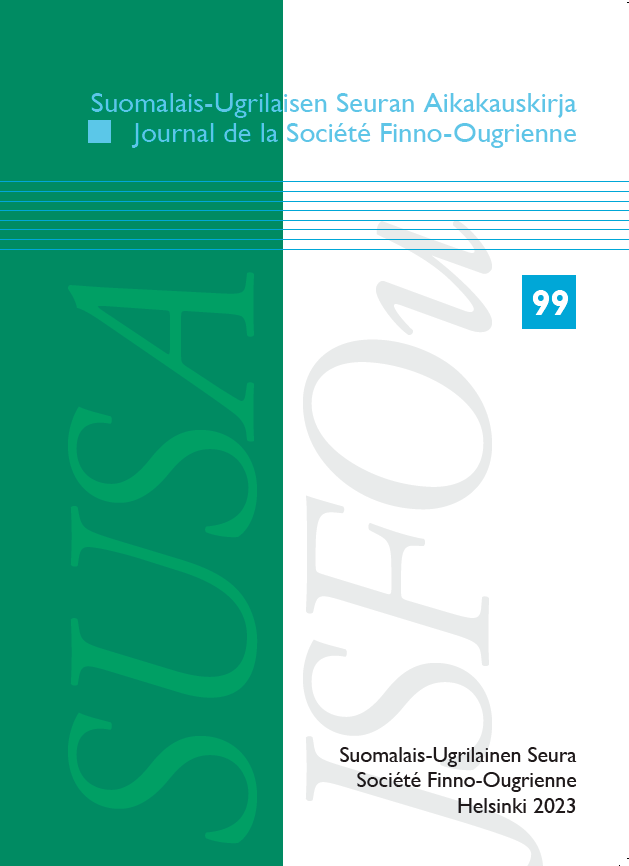Non-canonical structures in locative and existential predication in the Ob-Ugric languages
DOI:
https://doi.org/10.33340/susa.122981Avainsanat:
non-verbal predication, locative, existential, posture verb, ambiguityAbstrakti
The study at hand deals with different structures applied for expressing locative and existential predication in Khanty and Mansi, analysing a comparably large amount of data from various databases. Apart from the “expected” and traditionally described pattern “figure (theme) + ground (location) + copula”, the paper also accounts for posture verbs and transitive habeo-verbs playing a role in the named functional domain. Additionally, it is shown that a significant number of relevant clauses are structurally ambiguous between a locative and an existential reading. Finally, the paper underlines that the Ob-Ugric languages show a clear polarity split in the expression of locative and existential predication since the observed variation mainly touches affirmative clauses. In contrast, negative clauses are, as a rule, formed with negative existential particles.
Lähdeviitteet
Ajanki, Rigina & Laakso, Johanna & Skribnik, Elena. 2022. Nominal predication. In Bakró-Nagy, Marianne & Laakso, Johanna & Skribnik, Elena (eds.), Oxford guide to the Uralic languages, 981–995. Oxford: Oxford University Press.
Ameka, Felix K. & Levinson, Stephen C. 2007. Introduction: The typology and semantics of locative predicates: posturals, positionals, and other beasts. Linguistics 45(5/6). 847–871.
Bentley, Delia & Ciconte, Francesco Maria & Cruschina, Silvio. 2015. Existentials and locatives in Romance dialects of Italy. Oxford: Oxford Scholarship Online. <https://doi.org/10.1093/acprof:oso/9780198745266.001.0001>
Brykina, Maria & Orlova, Svetlana & Wagner-Nagy, Beáta. 2021. INEL Selkup Corpus. Version 2.0. (Publication date 2021-12-31.) <https://hdl.handle.net/11022/0000-0007-F4D9-1>.
Chappell, Hillary & Lü, Shanshan. 2022. A semantic typology of location, existence, possession and copular verbs: Areal patterns of polysemy in Mainland East and Southeast Asia. Linguistics 60(1). 1–82. <https://doi.org/10.1515/ling-2021-0219>
Clark, Eve. 1978. Locationals: Existential, locative and possessive constructions. In Clark, Eve & Greenberg, Joseph (eds.), Universals of human language. Vol. 4. Syntax, 85–126. Stanford [Ca.]: Stanford University Press.
Creissels, Denis. 2019. Inverse-locational predication in typological perspective. Italian Journal of Linguistics 31(2). 37–106.
Däbritz, Chris Lasse. 2021. Topik, Fokus und Informationsstatus: Modellierung am Material nordwestsibirischer Sprachen (Language, Context and Cognition 17). Berlin: De Gruyter.
DEWOS = Steinitz, Wolfgang. 1966–1988. Dialektologisches und etymologisches Wörterbuch der ostjakischen Sprache. Berlin: Akademie-Verlag.
Filchenko, Andrey. 2010. Aspects of the grammar of Eastern Khanty. Tomsk: TSPU Press.
Filchenko, Andrey et al. (eds.). 2010–2022. Annotated folklore and daily prose texts in the languages of the Ob-Yenisei area. Vol. 1–7. Tomsk: Tomsk State Pedagogical University.
Freeze, Ray. 1992. Existentials and other locatives. Language 68(3). 553–595.
Haspelmath, Martin. 2022. Nonverbal clause constructions. (Submitted manuscript. Lingbuzz/006673.) <https://ling.auf.net/lingbuzz/006673> (last accessed 2023-09-18).
Heine, Berndt. 1997. Possession: Cognitive sources, forces, and grammaticalization. Cambridge: Cambridge University Press.
Hengeveld, Kees. 1992. Non-verbal predication: Theory, typology, diachrony (Functional Grammar Series 15). Berlin: Mouton de Gruyter.
Honti, László. 2008. Habere “po-ural’ski”. Linguistica Uralica 44(3). 161–177.
Honti, László. 2013. Seinsverben und Kopulae im Uralischen. Linguistica Uralica 49(4). 241–272.
Kannisto, Artturi & Liimola, Matti. 1951. Wogulische Volksdichtung. Vol. 1. Texte mythischen Inhalts (Suomalais-Ugrilaisen Seuran Toimituksia 101). Helsinki: Suomalais-Ugrilainen Seura.
Kannisto, Artturi & Liimola, Matti. 1955. Wogulische Volksdichtung. Vol. 2. Kriegs- und Heldensagen (Suomalais-Ugrilaisen Seuran Toimituksia 109). Helsinki: Suomalais-Ugrilainen Seura.
Koch, Peter. 2012. Location, existence, and possession: A constructional-typological exploration. Linguistics 50(3). 533-603.
Kotorova, Elizaveta G. & Porotova, Tel’mina I. 2001. Ketskie fol’klornye i bytovye teksty. Tomsk: Tomskij gosudarstvennyj i pedagogičeskij universitet.
Laakso, Johanna & Wagner-Nagy, Beáta. 2022. Existential, locational and possessive clauses. In Bakró-Nagy, Marianne &
Laakso, Johanna & Skribnik, Elena (eds.), Oxford guide to the Uralic languages, 970–980. Oxford: Oxford University Press.
Lemmens, Maarten. 2002. The semantic network of Dutch posture verbs. In Newman, John (ed.), The linguistics of sitting, standing, and lying (Typological Studies in Language 51). 103–139. Amsterdam: John Benjamins.
Lyons, John. 1967. A note on possessive, existential and locative sentences. Foundations of Language 3(4). 390–396.
Milsark, Gary L. 1979. Existential sentences in English. New York: Garland.
Munkácsi, Bernát. 1896. Vogul népköltési gyűjtemény. Vol. 4. Életképek. Budapest: Magyar tudományos akadémia.
Németh, Szilvia. 2021. Az északi manysi ūnli ’ül’ testtartásige jelentésszerkezete és szinkrón megfigyelhető grammatikalizációs irányai. Nyelvtudományi közlemények 117. 29–68.
Newman, John. 2002. A cross-linguistic overview of the posture verbs ‘sit’, ‘stand’ and ‘lie’. In Newman, John (ed.), The linguistics of sitting, standing, and lying (Typological Studies in Language 51). 1–24. Amsterdam: John Benjamins.
Nikolaeva, Irina. 1999. Ostyak (Language of the World. Materials 305). Munich: LINCOM Europe.
Pustet, Regina. 2003. Copulas: Universals in the categorization of the lexicon. Oxford: Oxford University Press.
Sal, Éva K. 1955. A tagadás az obi-ugor nyelvekben. Nyelvtudományi közlemények 56. 57–69.
Sal, Éva K. 1956. A tagadás az obi-ugor nyelvekben II. Nyelvtudományi közlemények 57. 73–111.
Sipos, Mária. 2018. „A padok előtt tanári asztal ül.” A hanti ’ül’ szóból létrejött kvázi-kopuláról. Folia Uralica Debreceniensia 25. 215–232.
Sipos, Mária. 2019. 2 in 1 – A szinjai hanti lokatív mondatok egyik kvázikopulájáról. In Forgács, Tamás & Németh, Miklós &
Sinkovics, Balázs (eds.), A nyelvtörténeti kutatások újabb eredményei X, 299–310. Szeged: SzTE BTK Magyar Nyelvészeti Tanszék.
Sipos, Mária. 2021. A ’fekszik’ ige grammatikalizációja a szinjai hantiban. Folia Uralica Debreceniensia 28. 319–332.
Sipőcz, Katalin. 2015. Negation in Mansi. In Miestamo, Matti & Tamm, Anne & Wagner-Nagy, Beáta (eds.), Negation in Uralic languages (Typological Studies in Languages 108), 191–217. Amsterdam: John Benjamins.
Solovar, Valentina N. & Vylla, Natal’ja N. 2009. Dom v jazykovoj kartine chantov i nencev. In Myznikov, Sergej A. & Brodskij, Igor V. (eds.), Voprosy uralistiki 2009: Naučnyj almanach, 81–90. Sankt-Peterburg: Nauka.
Steinitz, Wolfgang. 1975. Ostjakologische Arbeiten. Vol. 1. Ostjakische Volksdichtung und Erzählungen aus zwei Dialekten: Texte. Edited by Gert Sauer. Den Haag: Mouton.
Steinitz, Wolfgang. 1989. Ostjakologische Arbeiten. Vol. 3. Texte aus dem Nachlass. Edited by Gert Sauer et alii. Berlin: Mouton de Gruyter.
Wagner-Nagy, Beáta. 2011. On the typology of negation in Ob-Ugric and Samoyedic languages (Suomalais-Ugrilaisen Seuran Toimituksia 262). Helsinki: Suomalais-Ugrilainen Seura.





